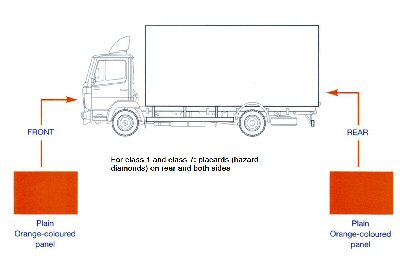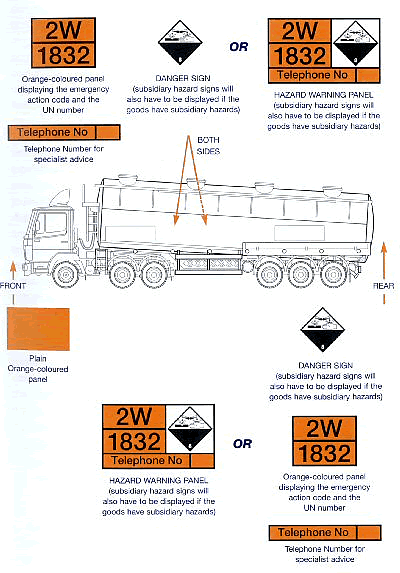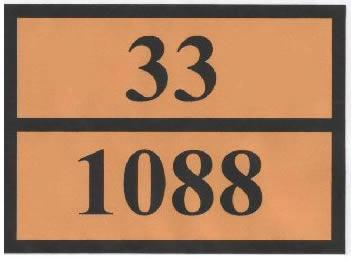CDG Regs
1 Regulation 5 is the basis for implementing the requirements of part 5 of ADR.
2 Depending on the case, these duties could fall on the packer, loader, consignor and/or carrier. The decision to be taken in the case of enforcement is "who was best placed to ensure compliance with the relevant provision". The effect of CDG Regs is that all participants have responsibilities. For example, even though it is the consignor's obligation to provide the carrier with documentation, the carrier commits a prima facie offence by travelling with non-compliant documentation. In practice the carrier can often only discharge his duty through the driver. A properly trained driver will recognise non-compliant documents but may be under pressure to accept them.
ADR
3 The relevant part of ADR is part 5. Obligations are set out in part 1.4 as follows. Note that unloader's obligations are new for ADR 2011.
Obligations of specific roles in ADR:
- Packer - 1.4.3.2
- Filler - 1.4.3.3
- Loader - 1.4.3.1
- Consignor - 1.4.2.1
- Carrier - 1.4.2.2
- Unloader - 1.4.3.7
4 There are linked requirements in part 8, but they make it the carrier's duty to ensure that the "transport unit" carries the documents, placards etc. that are required by Part 5.
5 Chapter 5.1 contains the general provisions and covers
- overpacks (see definition at 1.2.1)
- empty uncleaned packagings, tanks, vehicles and containers for carriage in bulk
- mixed packing
- approval and notification (uncommon)
- certificates (mostly radioactives)
Marking and labelling of packages (ADR 5.2)
5 These words mean something different, but in both cases refer to packages.
- Marking is described in 5.2.1 and comprises the UN Number and other information for certain classes (1, 2 and 7). Marking is also used to describe the UN package certification details (ADR 6.1.3 and in Packaging)
- Labelling is described in 5.2.2 and comprises "hazard diamond(s)" with the Class number (eg "3" for flammable liquids) and subsidiary hazard where specified. Details in column 5 of Table A. Specimen labels are shown in 5.2.2.2.2.
6 The details are to be found in the various sub-paragraphs within 5.2.1 and 5.2.2 respectively. This is highly prescriptive and includes special requirements for certain substances.
7 Size requirements are in 5.2.2.2.1.1. ADR permits some flexibility in labelling of refrigerated liquid gases (5.2.2.2.1.1), and also allows changes to the background colour of flammable gas labels for UN1011, 1075, 1965, and 1978 (5.2.2.2.1.6 (c))
8 There is an additional requirement to display an orientation label for certain packages (5.2.1.9).
9 Working logically through the sections enables the requirements to be precisely determined.
10 There are rules in CHIP for combined supply and carriage labelling. In any event the carriage labelling has to be applied.Placarding and marking of vehicles etc. (ADR 5.3)
11 As with marking and labelling these words mean different things, and apply to vehicles and containers, MEGCs (multi element gas container - defined in ADR 1.2.1), tank containers, and portable tanks.
- Placarding is described in 5.3.1 and refers to the "hazard diamonds" that are required for tanks, bulk and vehicles carrying class 1 or class 7 goods in packages.
- Marking is described in 5.3.2 and refers to the plain orange plates carried at the front of vehicles (and on the back of vehicles carrying packages) and to the other marks on the sides and backs of vehicles.
Placarding
12 Placarding is the process of placing on the tank, container etc. the hazard diamonds referred to in column 5 of table A (analogous to labelling of packages). The precise details of sizes and so on are at 5.3.1.7. For small tanks or containers smaller placards can be used (5.3.1.7.3 - allows "package labels" to be used).
13 Placards have to be displayed as indicated in 5.3.1.2 to 5.3.1.6 according to the type of load.
Marking
14 Marking is the process of placing on the vehicle and the tank, container etc, the orange plates. See ADR 5.3.2. Marking now also includes the EHS mark. where appropriate.
15 ADR allows the familiar plain orange plate to be divided by a horizontal black line (5.3.2.2.1).
Vehicles carrying packages
16 In all cases the plain orange plates for vehicles carrying packages are as described in ADR at 5.3.2.1.1. A plain orange plate is fixed at front and back of the "transport unit". Note the extra requirement for vehicles carrying class 1 (explosives) and class 7 ((radio-active substances) to display placards (hazard diamonds) on both sides and the rear of the vehicle (ADR 5.3.1.5).

Carrying packages in freight containers
17 This is similar to the above but in this case the freight container should display relevant placards (hazard diamonds) on all four sides of the container.

18 ADR includes Special Provision CV 36 (see 7.5.11 and table A column 18). This requires vehicles carrying packages of gases which could vitiate the atmosphere to be carried in open or ventilated vehicles/containers or if that is not feasible the cargo doors have to carry a suitable warning.
Tanks, tank containers etc
19 Different requirements apply to GB domestic journeys and international journeys. CDG Regs (at regulation 6 ) implements a national derogation that requires GB registered vehicles on GB domestic journeys to be marked with the familiar "Emergency Action Codes" (sometimes called "Hazchem codes"), and to include a telephone number for advice in the event of an emergency the requirement to display the plain orange plate at the front of the vehicle is the same as for packaged goods vehicles . Note that paragraph ) of schedule 1 allows the orange plate not to be fire resisting for tanks made before 1 January 2005. The same arrangements apply in Northern Ireland by virtue of their regulations.
GB registered vehicle on GB domestic journey

 Plus EHS mark where appropriate on both sides and rear
Plus EHS mark where appropriate on both sides and rear
Vehicles on international journeys
20 Vehicles with tanks etc on international journeys carry the HIN (hazard identification number – sometimes called the Kemler code) in the pattern shown at ADR para 5.3.2.2.3. For example:

These are in addition to the placards (hazard warning diamonds) described at para 12 above.
21 Plates should be displayed at the rear and both sides, with a plain orange plate at the front. Where one substance only is carried it is permissible to display plates at front and rear only provided the front plate also carries the HIN code and UN Number. There is no requirement to display a telephone number. An international journey is described at ADR 1.1.2.4.
Documentation
22 Chapter 5.4 of ADR covers this in the usual detail. The key requirements are that the documentation contains the following information (5.4.1.1):
- The UN Number
- Proper shipping name
- Class (with subsidiary hazard, if any, in brackets)
- Packing group (where assigned)
- Number and description of packages
- Total quantity of each item of different UN Number
- name/address of consignor
- name /address of consignee(s). Where there are multiple consignees not known at the start of the journey, the words "Delivery Sale" may be used.
- Declaration relating to any special agreement, where applicable (uncommon)
- Where assigned, the tunnel code, except where it is known that the journey will not involve passing through a relevant tunnel.
23 There is extra information required for Class 1 goods (explosives) (see ADR 5.4.1.2.1(e)), and for fireworks (UN numbers 0333, 0334, 0335, 0336, and 0337) information about the classification by the relevant competent authority (ADR 5.4.1.2.1 (g))
24 There are other rules for class 1 (explosives) class 2 (gases), class 4.1 (flammable solids etc.), class 5.2 (organic peroxides), class 6.2 (infectious substances) class 7 (radioactives). These are in ADR 5.4.1.2. The most likely to be met are those relating to gas mixtures where the composition of the mixture should be given (5.4.1.2.2(a).
25 The last part of ADR 5.4.1.1.1 prescribes the order in which this information is shown.
26 There is no requirement for all information to be on one document. Where a vehicle has picked up loads from more than one consignor this would clearly not be possible.
27 There are special rules for wastes, salvage packagings, and empty uncleaned packaging etc (5.4.1.1.3 to 5.4.1.1.6). For more on empty uncleaned packaging and wastes see Frequently asked questions
28 For empty tanks and bulk there are other rules about documentation in 5.4.1.1.6. See Frequently asked questions for a discussion of practical problems.
29 Where loads are being carried on domestic journeys under the limited load threshold (ADR 1.1.3.6 - more details in Main Exemptions) the requirement to carry documentation is disapplied (except for explosives and radioactives). Details in the document "Dangerous Goods: Approved Derogations and Transitional Provisions". The requirement to furnish the carrier with documentation still applies.
30 Other special rules cover
- Loads in a transport chain that includes air or sea (5.4.1.1.7)
- Carriage in "date expired" IBCs (5.4.1.1.11 - details in 4.1.2.2)
- Multi compartment tanks or transport units with more than one tank (5.4.1.1.13)
- Elevated temperature substances (5.4.1.1.14)
- Substances stabilised by temperature control (5.4.1.1.15)
Language and format
31 The language should be that of the forwarding country and one of English, French or German if not already on the document (5.4.1.4.1). This means that, especially for international journeys, the documents may not be in English and that is one reason why the layout of the information referred to in 5.4.1.1.1 is important.
Instructions in writing (Emergency information)
32 Emergency information is a separate consideration from documentation and is covered in Crew and Vehicle.